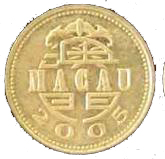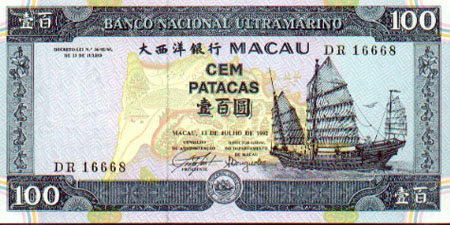|


The pataca (traditional Chinese: 澳門圓; ISO 4217 code: MOP) is the currency of Macau. It is subdivided into 100 avos (Cantonese: 仙; sin), with 10 avos called ho (毫) in Cantonese. The abbreviation MOP$ is commonly used.
Macau adopts the so-called currency board system under which the legal tender, Macanese pataca, is 100 percent backed by foreign exchange reserves, in this case currently the Hong Kong dollar. Moreover, the currency board, Monetary Authority of Macao (AMCM), has a statutory obligation to issue and redeem pataca on demand against the Hong Kong dollar at a fixed exchange rate and without limit.
History
The pataca was introduced in Macau and Portuguese Timor in the year 1894, but only as a unit of account. The unit initially corresponded to the Mexican dollar, and it replaced the Portuguese real at a rate of 1 pataca = 450 réis. The name pataca derives from the fact that the Portuguese always referred to the Mexican dollar as the 'Pataca Mexicana'.
At the end of the 19th century, there was no single currency in use in Macau, but the predominant circulating coins were the silver Mexican dollars, the British silver trade dollars of Hong Kong and the Straits Settlements, as well as the silver dollars and fractional coinage of the neighbouring province of Canton. In 1901, it was decided to have a uniquely Macau currency, and for that purpose, the Banco Nacional Ultramarino was granted exclusive rights to issue legal tender banknotes that were to be denominated in patacas. On January 27, 1906, pataca notes in denominations of 1, 5, 50 and 100 were introduced and all foreign coinage was outlawed, the idea being to make the pataca paper notes the sole legal tender currency in Macau. However, the Chinese, being so accustomed to using silver for barter, were suspicious of this new paper money, and as such, the paper pataca always circulated at a discount in relation to the silver dollar coins. On the contrary, a similar action at exactly the same time in the Straits Settlements, and for the same purpose, had the different effect of putting the new Straits dollar unto the gold exchange standard. Hence both the Macau pataca and the Straits dollar were launched at a sterling value of 2 shillings and 4 pence, but where the Straits dollar remained at that value until the 1960s, the Macau pataca fluctuated with the value of silver, just like the Hong Kong unit.
In 1935, when Hong Kong and China abandoned the silver standard, the Hong Kong unit was pegged to sterling at a rate of 1 shilling and 3 pence, while the Macau pataca was pegged to the Portuguese escudo at a rate of 5.5 escudos. This meant that the Macau pataca was worth only 1 shilling sterling and was therefore at a discount of 3 pence sterling in relation to the Hong Kong unit.
In 1980, the Macau government set up the Issuing Institute of Macau (Instituto Emissor de Macau; abbr. as IEM), which was given the monopoly right to issue pataca notes. The BNU became the IEM's agent bank and continued to issue banknotes. On agreement with the BNU on October 16, 1995, the Macau branch of Bank of China (中國銀行澳門分行) became the second note-issuing bank. The authority to issue patacas was transferred to the Monetary Authority of Macau.
Coins
Coins were not issued for use in Macau until 1952, with the 20 cent coin of Canton Province circulating. In 1952, bronze 5 and 10 avos, cupro-nickel 50 avos and .720 fineness silver 1 and 5 patacas were introduced. Nickel-brass replaced bronze in 1967, including the last issue of 5 avos. Nickel replaced silver in the 1 pataca in 1968. In 1971, a final (.650 fineness) silver issue of 5 patacas was produced.
Brass 10, 20 and 50 avos and cupro-nickel 1 and 5 patacas were introduced in 1982. The 20 avos and 5 patacas became dodecagonal in 1993 and 1992, respectively, whilst a bimetallic 10 patacas was introduced in 1997 and a cupronickel 2 patacas in 1998. Coins are issued by the Monetary Authority of Macao.
Banknotes
In a similar arrangement to the issue of banknotes in Hong Kong, Macanese banknotes are not issued by a central bank or monetary authority but by two commercial banks, the Banco Nacional Ultramarino and the Bank of China. Owing to Macau's Portuguese colonial past, banknotes are printed in Portuguese as well as Chinese, including the name of the Bank of China which is written as both "Banco da China" and "中國銀行".
Following the initial issues of pataca banknotes in 1906, the new currency was supplemented the following year by 10 and 25 pataca notes, and in February 1920, 5, 10 and 50 avo notes were added. In 1923, the Banco Vui Hang introduced 10 pataca notes which stated that they were backed by Cantonese 20 cent coins. These notes were followed until 1934 by cashier's cheques issued by various banks in denominations of 1, 5, 10, 50, 100, 200, 400, 800 and 1000 dollars, presumably equivalent to the pataca. The BNU issues were augmented by 1 and 20 avo notes in 1942, and in 1944, 500 pataca notes were introduced. Also in 1944, further cashier's cheques were issued, denominated 1000 yuan and NC$5000. The 25 pataca note was discontinued after 1958.
On August 8, 1988, BNU issued a 1000 pataca banknote, the highest value banknote yet. Because 8 in Chinese (Ba) is similar to "getting rich" (Fa; 發), this unique date, which occurs only once per century, gives the note a special meaning. Another feature is the replacement of the Coat of arms of Portugal with BNU's logo, shedding a political symbol in the prospect of reunification with China. In 1995, the Banco da China introduced notes in denominations of 10, 50, 100, 500 and 1000 patacas. Both the BNU and Banco da China introduced 20 pataca notes in 1996.
Current issue
Banknotes are currently issued in denominations of 10, 20, 50, 100, 500 and 1000 patacas. The current series of BNU banknotes was issued in 2005, while the Bank of China notes were last issued between 1995 and 2003. The dimensions of the banknotes are "coincidentally" the same as that of Hong Kong banknotes worth the corresponding number of dollars. On December 20, 1999, the day Macau was retroceded to China, banknotes of all values (except for 10 patacas) by both banks were reissued with that date. On January 5, 2009, the Monetary Authority of Macau announced a new series of banknotes, dated 2008, released by the Bank of China.
The 2005 series of BNU was printed by Royal Joh. Enschedé, a security printing firm in the Netherlands.
Despite the fact that the pataca is the official currency of Macau, most of the money in circulation in the territory is actually Hong Kong dollars. Patacas accounted for only 29.9% of Macau's money supply at the end of 1998.
The exchange rate is pegged and is approximately MOP$103 for HK$100 as of February 2004. For United States dollars, to which the Hong Kong dollar is in turn loosely pegged, the exchange rate is around 8 patacas to 1 US dollar. Although it is possible to exchange patacas in Macau, it is either difficult or impossible to do so elsewhere. The few places in Hong Kong where patacas are available are concentrated on Cleverly Street, a short distance from the Macau Ferry.
Although the pataca is the legal tender of Macau, the Hong Kong dollar is almost universally acceptable in the city, and in some cases, is preferred to the Pataca. Circulation of the pataca is mandated by a decree (Decreto-Lei n.º 16/95/M) prohibiting refusal by merchants, but some casinos flout this rule and refuse bets in patacas. The Hong Kong dollar and renminbi are generally accepted throughout Macau from casinos to restaurants. Payments to government agencies can also be made in both Hong Kong dollars and patacas.
As there are currently no restrictions on the import or export of either local or foreign currency into or from Macau, visitors can change their currency in hotels, banks and authorized exchange dealers located all around the city. There are also 24-hour exchange counters at Macau International Airport (Taipa Island) and at the Lisboa Hotel (Macau Peninsula) for customers if they want to change their currency into patacas outside working hours.
The text on this page has been made available under the Creative Commons Attribution-ShareAlike License and Creative Commons Licenses
|
